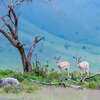
NIMMO BAY WILDERNESS RESORT
AS OUR FLOAT PLANE splashes down at Nimmo Bay Wilderness Resort, it’s clear this isn’t going to be an ordinary summer vacation.
We’re in British Columbia’s Great Bear Rainforest, completely cut off from the outside world, but with all the creature comforts of home – even more in fact.
Through the plane window I spot half a dozen cabins perched on stilts along the waterfront where we’ll fall asleep each night under cozy down duvets.

Stepping onto the dock, I’m captivated by the sight of a building that looks like it might just take flight. Walls of yellow cedar shakes are topped with a soaring black roofline. This is the lodge, where we’ll enjoy extraordinary meals and sip drinks flavoured with seaweed and other local ingredients.
Hidden in the forest beside the waterfall cascading down Mount Stephens are a couple of hot tubs and a cabin where I’ll experience one of the best massages of my life.
If you’ve ever camped, you know how harsh nature can be. And if you’ve ever camped in a remote place, you know how challenging that can be, lugging food, a tent and gear with you. It’s a privilege, therefore, to be able to experience raw nature in comfort, with guides to interpret what we see, and staff that leave us alone when we want to enjoy the solitude and tranquility.
In fact, Nimmo Bay Wilderness Resort could be the poster place for National Geographic Unique Lodges of the World, so perfectly does it embrace the ethos of the conservation-minded brand. After launching its coveted collection of lodges in 2015 with just 24 properties, today National Geographic’s Unique Lodges of the World number 63 properties on six continents, with more on the way.
 Room with a view in one of the luxury ocean-facing cabins
Room with a view in one of the luxury ocean-facing cabins
The landscapes you’ll find them in are as different as the lodges themselves; from the wetlands of Africa’s Okavango Delta to the Atacama Desert of Chile; from the High Atlas Mountains of Morocco to the low-lying islands of the Seychelles.
For National Geographic, it’s not about luxury, although most of their lodges offer plenty of that. Instead, it’s about the more mundane, but ultimately more important concept of sustainability. That is, protecting natural and cultural heritages, supporting local communities and focusing on environmentally friendly practices.
Here at Nimmo Bay, those concepts were woven into the fabric of the place from day one, when founders Craig and Deborah Murray started a heli-fishing lodge in the early 1980s. The waterfall, for instance, powers a Pelton wheel turbine, which provides up to 80 percent of the resort’s energy.
Most of the food we enjoy – from smoked albacore tuna to crispy pork belly – comes from the natural bounty of this coast and from farms on nearby Vancouver Island. Sometimes, it even comes from one of the local First Nations, like the euchalon I tried for the very first time. The oily fish is prized by indigenous people and was historically bartered or given as gifts in traditional potlach ceremonies.
 Tranquility in the wellness hot tub
Tranquility in the wellness hot tub
The Murrays foster close relationships with indigenous locals and employ them as guides. One morning Irvin Speck takes me hiking in the surrounding old growth forest and shows me how his people harvest sap from the bark of Balsam fir trees for tea, something he still drinks every day.
Concern for their community also extends to the wildlife. A few years ago, eldest son Fraser Murray and his wife Becky came up with an ingenious idea they called ‘Bullets for Binos.’ Grizzly bear hunters who agreed to give up their hunting ‘tags’ and pledged never to hunt grizzlies again would be rewarded with a complimentary three-day stay and a pair of binoculars.
SEAL RIVER HERITAGE LODGE
BEARS ARE ALSO on the minds of the owners and operators of another National Geographic lodge half-way across the continent. At Seal River Heritage Lodge, a 30-minute flight north of Churchill, Manitoba, it’s polar bears that are front and centre, quite literally. On my first afternoon there, a big male wanders right up to the lodge, his long snout waving in
the air, no doubt detecting the delicious odours emanating from the kitchen.
Churchill Wild, the company that built and operates Seal River and three other lodges on the Hudson Bay coast, pioneered the concept of walking safaris 27 years ago.
 Wildlife viewing from Seal River Heritage Lodge
Wildlife viewing from Seal River Heritage Lodge
In November, when I arrive, polar bears are patiently waiting for ice to form on the bay so they can go offshore and hunt seals, their favourite food. When we leave the lodge on our twice-daily walks, our guides carry guns, just in case, but they’ve never had to shoot a bear. We walk close together in single file. “We want to be one visual presence,” explains lead guide Andy McPherson before our first walk. “It’s unbelievably effective and far less intrusive than firing guns. You’ll be amazed how easy it is to scare away a bear.”
There’s nothing easy about operating a high-end lodge in the Arctic. Everything from food to fuel has to be flown in from Churchill by small plane. The company even had to build its own runway.
 The lounge
The lounge
Churchill Wild has devised various strategies to make this way off-the-grid lodge as sustainable as possible. Solar panels provide most of its power and water is pumped from a nearby lake. Staff forage wild food such as berries, greens and mussels. Waste gets recycled or composted and planes never fly empty.
Despite the challenges, the lodge is so comfortable and cozy it’s hard to leave. During my visit, one of the 15 guests – a woman from Florida – stays inside the entire three days and enjoys wildlife through the expansive windows.
THE RANCH AT LAGUNA BEACH
IT TAKES EFFORT AND commitment to be accepted as a National Geographic lodge, even if you’re on the grid in environmentally conscious California. “It was a huge vetting process,” says Kurt Bjorkman, general manager of The Ranch at Laguna Beach, as we watch golfers get ready to tee off one January morning.
“They [a National Geographic team] come out and spend a week with you, making sure you’re everything you say you are, that you’re not faking it,” he says. “It took us almost two years to become accepted – it was incredibly intense – but validating once we were approved.”

The Ranch was the first – and is still the only – National Geographic brand member in California. Tucked into a narrow box canyon, it’s home to Ben Brown’s Golf Course – what is surely one of the most scenic golf courses anywhere.
The lush greens hug the curving walls of Aliso and Wood Canyons, which seem to rise almost straight out of the ground. “The energy that comes from these hills is just tremendous,” says Bjorkman. “Whether that’s something spiritual or just physical….”, he shrugs, adding that Laguna Beach is known as a wellness destination.
The golf course came first, in 1950, and low-rise accommodation was added later. When new owners re-built a few years ago, they took care to retain the property’s historical footprint. Today, The Ranch’s casually elegant rooms and suites, along with its intimate Sycamore Spa, make it one of SoCal’s top resorts.
During our visit, my daughter and I walked to the nearby beach, hiked one of dozens of trails that cut through the surrounding hillsides, toured The Ranch’s half-acre organic garden and – yes – did our best at a game of golf.

Bjorkman, who now sits on the advisory council for National Geographic lodges, is proud of The Ranch’s sustainability initiatives, which include the recent purchase of a state-of-the-art glass crusher. The machine grinds beverage bottles into sand, which is then used to line the bunkers of the golf course and walkways. In 2019 that crushed glass added up to 45 metric tonnes of sand. Not only does it make good use of the glass, but as Bjorkman points out, it also alleviates the need for trucks coming onto the property to pick up bottles to recycle elsewhere.
Perhaps the best part of staying at a National Geographic Unique Lodge of the World isn’t that it’s highly enjoyable, but that it makes a difference.
The lodge program is part of the bigger National Geographic Society brand, which aims to explore and protect the planet by awarding grants to researchers, scientists, explorers, innovators and storytellers around the world.
Every time you stay at a National Geographic lodge you’re contributing to their valuable work. If only saving the planet could always be this much fun.
Written by Suzanne Morphet for Cruise & Travel Lifestyles (Fall/Winter 2020-21)
Featured
Popular Articles & Videos
- Video: Meet the Wine Maker in the 'Tuscany of Austria' on the Danube
- You Need This Suitcase For Your Next Trip to Wine Country
- 3 New, Impossibly Picturesque Boutique Hotels That Make it Easy to Dream About Your Next Trip to Europe
- Cruising with History on Sea Cloud
- Video: Alaska Wildlife Encounters You Can't Miss












